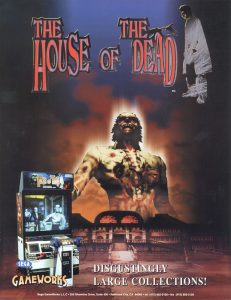 In 1936, when Seeburg unveiled their Ray-O-Lite, the very first light gun game, they couldn’t have imagined the profound effect it would have on the future of video games. Nor could they imagine the shambling, shuffling horrors players would gun down exactly 60 years later with the release of Sega’s The House of The Dead in 1996.
In 1936, when Seeburg unveiled their Ray-O-Lite, the very first light gun game, they couldn’t have imagined the profound effect it would have on the future of video games. Nor could they imagine the shambling, shuffling horrors players would gun down exactly 60 years later with the release of Sega’s The House of The Dead in 1996.
From Nintendo’s Duck Hunt to Konami’s controversial Lethal Enforcers, gamers and arcade die-hards were more than familiar with light gun shooters by the time The House of The Dead arrived. But, Sega’s undead shooter would help usher in a shambling, brain-hungry renaissance that continues to thrive over twenty years later. Games like Left 4 Dead to movies like 28 Days Later and the comic-book-turned-television-show The Walking Dead, have been immensely popular, but Sega’s The House of The Dead has forever shaped pop culture. It all began with Sega’s AM1 development team and a young video game director.
The Silver Screen Meets Light Gun Horror
Shortly after graduating from university, Takashi Oda found himself working as a director within Sega’s AM1 development team. The AM1 team was Sega’s earliest development branch, having been founded in 1984. Oda cut his teeth on the lesser known Puzzle & Action: Treasure Hunt, a simple arcade mini-game series. After development on Puzzle & Action wrapped, Oda was recruited for a new project in very early development: a horror game that utilized Sega’s Virtua Cop light gun technology. The then-untitled game was still in early on and went through multiple revisions. At one point in development, it was even set to feature ghosts. Oda and other team members quickly dismissed this idea. As Oda later reflected, invisible enemies were wrong for an action shooter. Then, at this still-early stage, Oda had a stroke of inspiration while sitting in a movie theater watching the film Seven. Oda was struck by the film’s grim aesthetic. “One of the things that has influenced The House of the Dead is the film Seven. I saw it in the theater when we were creating The House of the Dead 1, and it was incredibly memorable… Even when I watch it now, the atmosphere and the visual presentation still impresses me,” Oda said in an interview.
Now, Oda knew, the game must have a darker, unsettling tone with strong cinematic impressions. This translated into it film grain look and noir feel. With the project slowly taking shape, it still lacked one important piece: a title. Several different names were tossed around during development. Some of these early titles included The Horror Show, Zombie, and the less compelling The Deadly Dead. Fortunately, none of these stuck. Instead, the team settled on The House of The Dead. Their reason for this title was straightforward: it looked cool. None of the development team spoke English, and they ultimately chose the game’s name based on how the words looked together. With all of the pieces falling into place, The House of The Dead quickly came into fruition.
Shambling into Arcades
The House of The Dead takes place in an undisclosed part of Europe. One or two players are tasked with investigating the mansion and underground compound of Dr. Roy Curien – a geneticist obsessed with eternal life. Players combat numerous over-the-top undead abominations as they delve deeper into Curien Mansion. Along the way, they’re challenged with saving civilians while gunning down Curien’s horrors.
Sega developed its classic in only 15 months. The time crunch resulted in the AM1 team having to scale back some of the initial design concepts, including an idea to allow players to take branching paths through the narrative. Despite a tight development schedule, the final product was nonetheless technologically impressive. It was built on the Virtua Cop game engine and was available in two cabinet configurations. The first was a standard upright model with a 25-inch monitor. A larger, deluxe model featured a 45-inch rear projection screen with an extended coin insertion console that also acted as gun holsters.
The Zombie Revival Began in The Far East
The House of The Dead was released in Japanese arcades on September 13, 1996. Several months earlier, in March, another similarly themed game for the PlayStation, Biohazard, hit Japanese store shelves. Biohazard was developed by Capcom and is more widely known by its North American title: Resident Evil. As both games made their way to European and North American markets, they quickly captured the attention of gamers and the general public. Together, they helped revive interest in the zombie genre. The House of The Dead was ported to both Microsoft Windows and the Sega Saturn. Soon afterwards, a follow-up sequel was released. Both titles would continue to spawn sequels and spin-offs as part of decades-long franchises.
Zombies, which were out of vogue in the late ’90s, quickly became a phenomenon after The House of The Dead’s release. The game initially inspired a resurgence of Asian zombie cinema. Soon afterwards, a rise in popularity of similar films followed in the West. Movies like 28 Days Later (2002), House of The Dead (2003) – which was inspired by its namesake – and Shaun of The Dead (2004) played across American movie screens. Likewise, other video game series like Dead Rising (2006), Left 4 Dead (2008), and The Last of Us (2013) followed suit. Even games with no direct ties to the genre, like the wildly popular Minecraft (2011), saw fit to include zombies.
As the zombie genre grew and spread, many of its important figures credited Japanese gaming for inspiring the resurgence. In a 2013 interview, George A. Romero, writer and director of Night of the Living Dead (1968), commented, “I think the zombie became popular because of Resident Evil and because of House of the Dead and because of video games more than anything else.” Echoing this belief, Kim Newman, a journalist and film critic, wrote in his book Nightmare Movies (2011): “The zombie revival began in the Far East.” Further commenting, “The key Japanese titles in the ongoing march of zombie hordes to world domination weren’t even films. Capcom’s PlayStation Biohazard/Resident Evil and Sega’s first-person-shooter The House of The Dead both appeared in 1996.”
The House of The Dead Lives On
With more than 10 standalone sequels and spin-offs, The House of The Dead continues to live on well over 20 years after its release in Japan. Currently, first two games are slated for an HD remake for modern consoles. Oda, who still acts as creative director on the series, has stated he has plans for at least three more entries.
While the zombie renaissance has slowed in recent years, there is no denying that The House of The Dead has influenced worldwide pop culture. Without Sega, Oda, and The House of The Dead, zombie media, including the wildly popular television show The Walking Dead and innumerable films, books, and video games, may have remained the stuff of forgotten B-movie horror.
About the Author: Gene Goodman is vice president of M&P Amusement, a distributor of new and quality refurbished used arcade games and pinball machines in operation since 1932 and headquartered in York, Pennsylvania.
House of the Dead arcade flyer property of The Arcade Flyer Archive.

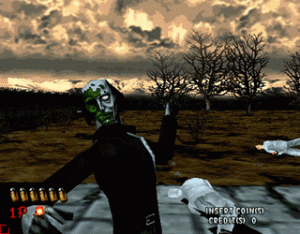
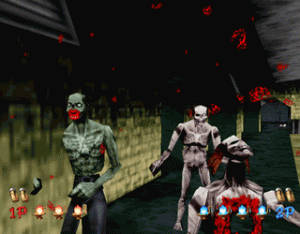
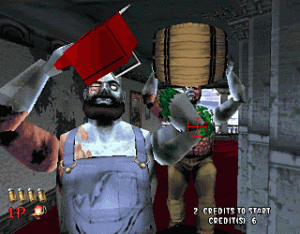
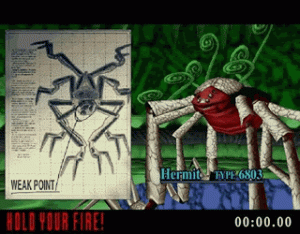
Recent Comments